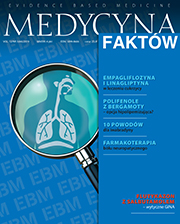Jak wdrażać i stosować empagliflozynę w gabinecie lekarza POZ? Artykuł przeglądowy
##plugins.themes.bootstrap3.article.main##
Abstrakt
W pracy przybliżamy wnioski płynące z 3-letniego badania EMPA-REG OUTCOME, w którym chorym na cukrzycę typu 2 z wysokim ryzykiem sercowo-naczyniowym do terapii dołączano empagliflozynę.
##plugins.themes.bootstrap3.article.details##
Jak cytować
Sapilak , B. J., Mastalerz-Migas, A., & Dzida , G. (2019). Jak wdrażać i stosować empagliflozynę w gabinecie lekarza POZ? . Medycyna Faktów , 12(3(44), 261-264. https://doi.org/10.24292/01.MF.0319.13
Numer
Dział
Artykuły
Copyright ? by Medical Education. All rights reserved.
Bibliografia
1. Zinman B., Wanner C., Lachin J.M. et al.; EMPAREG OUTCOME Investigators: Empagliflozin, cardiovascular outcomes, and mortality in type 2 diabetes. N. Engl. J. Med. 2015; 373: 2117-2128.
2. Zinman B., Nauck M.A., Bosch-Traberg H. et al.: Liraglutide and Glycaemic Outcomes in the LEADER Trial. Diabetes Ther. 2018; 9(6): 2383-2392.
3. American Diabetes Association. Pharmacologic approaches to glycemic treatment. Standards of medical care in diabetes ? 2019. Diabetes Care 2019; 42(supl. 1): S90-102.
4. Davies M., D?Alessio D., Fradkin J. et al.: Management of Hyperglycemia in Type 2 Diabetes, 2018. A Consensus Report by the American Diabetes Association (ADA) and the European Association for the Study of Diabetes (EASD). Diabetes Care 2018; 41(12): 2669-2701.
5. Das S.R., Everett B.M., Birtcher K.K. et al.: 2018 ACC Expert Consensus Decision Pathway on Novel Therapies for Cardiovascular Risk Reduction in Patients With Type 2 Diabetes and Atherosclerotic Cardiovascular Disease: A Report of the American College of Cardiology Task Force on Expert Consensus Decision Pathways. J. Am. Coll. Cardiol. 2018; 72(24): 3200-3223.
6. Ferrannini E., Muscelli E., Frascerra S. et al.: Metabolic response to sodium-glucosecotransporter 2 inhibition in type 2 diabetic patients. J. Clin. Invest. 2014; 124: 499-508.
2. Zinman B., Nauck M.A., Bosch-Traberg H. et al.: Liraglutide and Glycaemic Outcomes in the LEADER Trial. Diabetes Ther. 2018; 9(6): 2383-2392.
3. American Diabetes Association. Pharmacologic approaches to glycemic treatment. Standards of medical care in diabetes ? 2019. Diabetes Care 2019; 42(supl. 1): S90-102.
4. Davies M., D?Alessio D., Fradkin J. et al.: Management of Hyperglycemia in Type 2 Diabetes, 2018. A Consensus Report by the American Diabetes Association (ADA) and the European Association for the Study of Diabetes (EASD). Diabetes Care 2018; 41(12): 2669-2701.
5. Das S.R., Everett B.M., Birtcher K.K. et al.: 2018 ACC Expert Consensus Decision Pathway on Novel Therapies for Cardiovascular Risk Reduction in Patients With Type 2 Diabetes and Atherosclerotic Cardiovascular Disease: A Report of the American College of Cardiology Task Force on Expert Consensus Decision Pathways. J. Am. Coll. Cardiol. 2018; 72(24): 3200-3223.
6. Ferrannini E., Muscelli E., Frascerra S. et al.: Metabolic response to sodium-glucosecotransporter 2 inhibition in type 2 diabetic patients. J. Clin. Invest. 2014; 124: 499-508.
